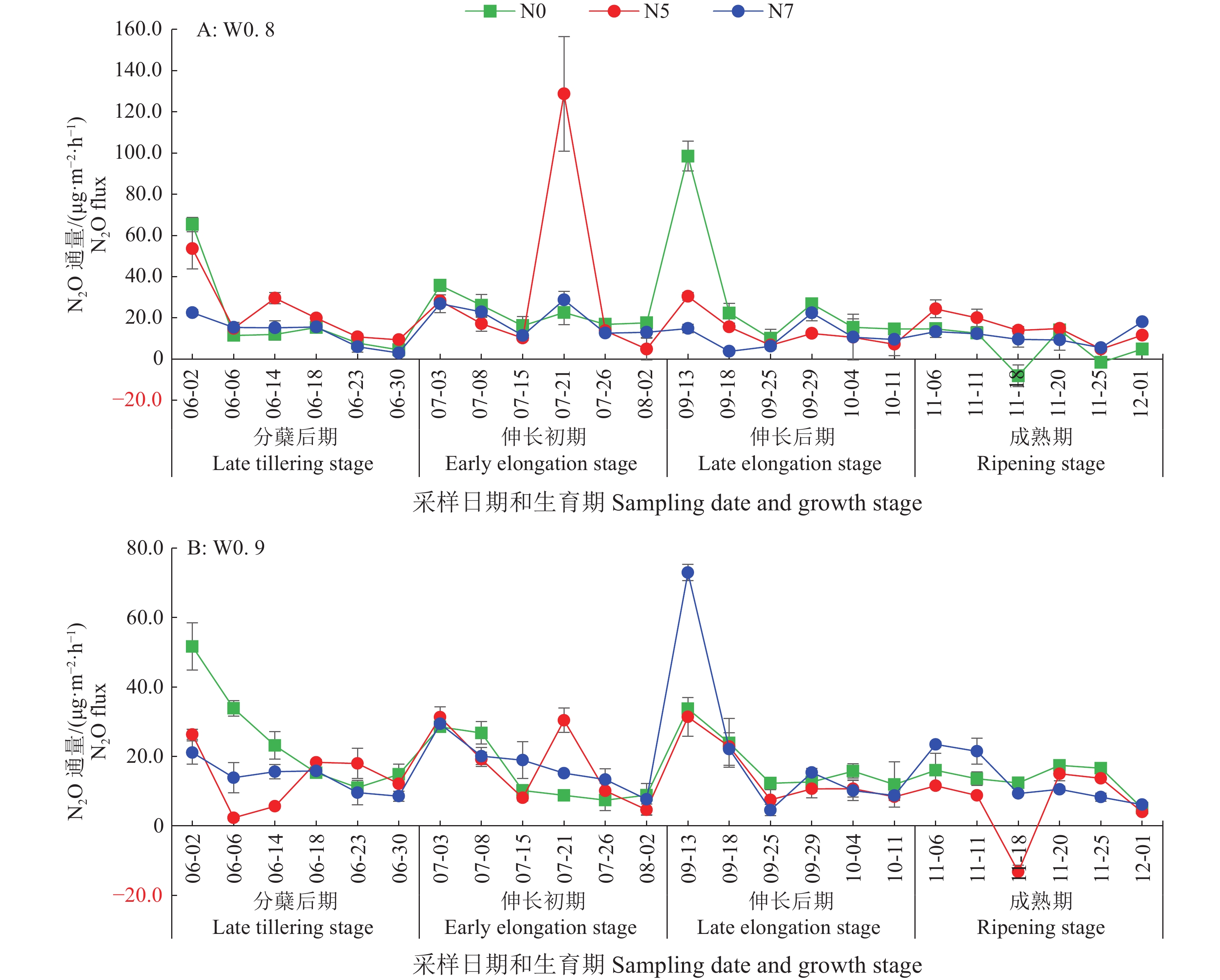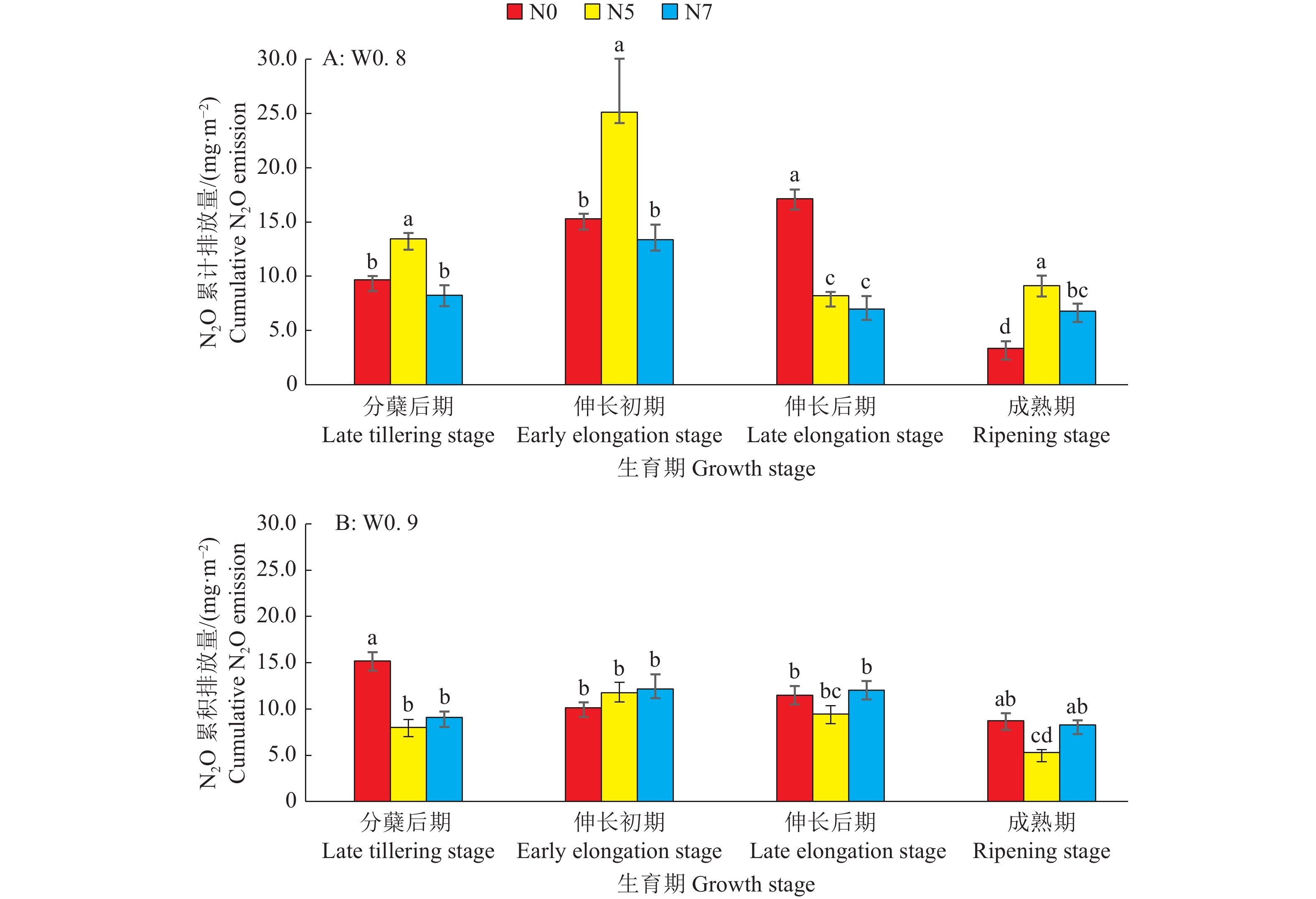Effect of nitrogen fertigation management on soil nitrogen fractions and N2O emissions from ratoon sugarcane fields
-
摘要:目的
研究滴灌追氮管理对宿根蔗田土壤氮组分和N2O排放的影响,揭示影响土壤N2O通量的土壤因子。
方法以二代宿根蔗Saccharum officinarum为研究对象,在移动防雨棚内进行2个滴灌灌水量[田间持水量的70%~80%(W0.8)和田间持水量的80%~90%(W0.9)]及3种滴灌追氮比例(等氮量250 kg·hm−2,其中,N0为用作追肥的氮肥全部施用到土壤中,N5为50%土施追氮、50%用滴灌系统施用,N7为30%土施追氮、70%滴灌追氮)的田间试验。在甘蔗生长的各个时期测定蔗田土壤N2O通量、pH和氮组分含量,并分析土壤N2O通量与土壤pH和氮组分含量的关系。
结果土壤N2O通量在施用氮肥和灌水后2 d较高,其中,分蘖后期和成熟期W0.9N5处理的土壤N2O通量显著低于其他处理。W0.9条件下,分蘖后期N5处理的土壤N2O累积排放量分别比N0和N7低47.3%和11.8%,伸长后期N5处理的土壤N2O累积排放量比N7低21.5%。相同滴灌追氮比例下,土壤硝态氮含量表现为W0.9>W0.8,随着灌水量的增加,土壤硝态氮含量有所增加。在伸长初期和成熟期,W0.8 N5处理的土壤铵态氮含量比W0.8 N0高56.4%和71.8%、比W0.8 N7高68.5%和160.3%。在分蘖后期,相同滴灌灌水量下,土壤微生物量氮含量表现为N5>N7>N0,W0.8和W0.9两种灌水量下,N5处理的土壤微生物量氮含量分别较N0处理高120.0%和100%。土壤N2O通量与铵态氮含量之间呈正相关关系(r=0.313),与硝态氮含量之间呈负相关关系(r= −0.391)。
结论W0.9N5处理可以降低土壤N2O排放,且土壤铵态氮和硝态氮含量影响土壤N2O通量,即土壤铵态氮含量越高,土壤N2O通量越高,而土壤硝态氮含量越高,土壤N2O通量却越低。
Abstract:ObjectiveTo study the effects of drip irrigation nitrogen (N) chasing management on soil N fraction and N2O emission in host cane fields, and reveal the soil factors affecting soil N2O fluxes.
MethodTwo water drip irrigation levels of W0.8 (70%−80% of field water holding capacity) and W0.9 (80%−90% of field water holding capacity) and three drip irrigation N chasing ratios (250 kg·hm−2 of equal N) were carried out in a mobile rain-proof shelter with the second generation host cane (Saccharum officinarum) as the research object. N0 was all the N fertilizer applied to the soil (referred to as soil-applied N); N5 was 50% soil-applied N and 50% applied by drip irrigation system (referred to as drip-applied N); N7 was 30% soil-applied N and 70% drip-applied N in the field trials. Soil N2O flux, pH and nitrogen fraction content were measured at each period of sugarcane growth, and the relationship between soil N2O flux and soil pH/nitrogen fraction content was analyzed.
ResultSoil N2O flux was higher after two days of applying N fertilizer and water irrigation, and the soil N2O flux of W0.9N5 was significantly lower than other treatments at the late tillering stage and maturity stage. Under W0.9, the cumulative soil N2O emissions in N5 at the late tillering stage were 47.3% and 11.8% lower than those of N0 and N7, and 21.5% lower than those of N7 at the late elongation stage. Soil nitrate N content showed W0.9 > W0.8 for the same drip irrigation N rate, and increased with the increase of water irrigation. At the early elongation and maturity stage, the soil ammonium N content of N5 under W0.8 was 56.4% and 71.8% higher than those of N0, was 68.5% and 160.3% higher than those of N7. At the late tillering stage, soil microbial biomass nitrogen showed N5 > N7 > N0 under the same water drip irrigation level, and soil microbial biomass nitrogen of N5 was 120.0% and 100% higher than N0 under both water irrigation rates, respectively. There was a positive correlation between soil N 2O flux and ammonium N content (r=0.313) and a negative correlation with nitrate N (r=−0.391).
ConclusionW0.9N5 treatment can reduce soil N2O emissions, and soil ammonium N content and nitrate N content affect soil N2O flux, i.e., higher soil ammonium N content is associated with higher soil N2O flux, while higher soil nitrate N content is associated with lower soil N2O flux.
-
Keywords:
- Ratoon sugarcane /
- Fertigation /
- Sugarcane field soil /
- Inorganic nitrogen /
- N2O emission
-
钾是农作物生长必需的三大营养元素之一[1].我国呈现出不同程度的土壤缺钾现状, 且南方较北方的缺钾情况严重, 如广东的水稻土壤、旱地土壤缺钾面积均达到了90%以上[2].同时, 可利用的水溶性钾矿资源短缺, 供给量仅占需求量的30% ~ 40%, 进口已成为钾肥的主要来源[3].我国的非水溶性钾矿资源却非常丰富, 达到了100亿t[4].充分开发利用这部分资源, 将极大缓解我国的缺钾现状.我国对非水溶性钾矿已做了较多的研究[5-6], 然而大部分的提钾工艺复杂, 成本高, 难以推广.近年来, 基于活化概念的理化促释技术提供了一条新型研发思路[7].已有的研究结果表明, 活化后钾长石的钾释放量显著提高, 可部分替代氯化钾而肥效不减[8-9].开展活化钾矿的钾素释放机理与规律的理论研究, 尤其是对动力学规律的研究, 对其肥力评价指标的建立具有重要意义.
钾的释放既受含钾矿物类型的影响, 也受钾释放的溶液环境(如各种离子种类和浓度)的影响[10].范钦桢[11]发现铵态氮肥中的NH4+会抑制土壤中非交换态钾和结构钾的释放, 土壤中常见的阳离子有NH4+、Na+、Ca2+等, 而这些阳离子同样会影响非水溶性钾矿的释放.王瑾[12]研究了不同阳离子盐溶液对黑云母、白云母、正长石等非水溶性钾矿钾释放的影响, 发现随着离子种类、钾矿类型的不同, 钾的释放也呈现不同的释放特征.本研究选取2种钾矿及其QN活化钾矿为研究材料, 采用NH4Cl和NaCl这2种阳离子盐溶液做浸提剂对其连续振荡提取, 建立活化钾矿的钾释放动力学模型, 旨在从动力学角度研究活化钾矿的高效释放特征, 为评价活化钾矿的植物有效性提供理论依据.
1. 材料与方法
1.1 材料
供试的非水溶性钾矿为钾长石和富钾页岩, 其中, 钾长石w (K2O)为8.57%, 取自广东五华; 富钾页岩w(K2O)为11.42%, 取自河北张家口.2种钾矿经风干、磨细后过100目筛备用.
活化钾矿的制备方法:分别称取上述钾矿20 g, 加入质量分数为5%的QN活化剂, 再加入2 mL蒸馏水, 混合研磨5 min, 风干、磨细, 过100目筛备用.其中, QN活化剂为含Na+、不含K+的无机活化剂.
浸提剂分别为10 mmol·L-1的NH4Cl和NaCl.
1.2 方法
准确称取钾矿及活化钾矿0.500 0 g于离心管中, 分别加入50 mL不同的浸提剂溶液, 对照加入去离子水(H2O), 摇匀, 在振荡机上振荡15 min, 取出后5 000 r·min-1离心.倒出全部上清液, 用火焰光度法测定溶液钾的含量.残渣中分别加入50 mL上述溶液, 重复浸提步骤, 钾长石、活化钾长石连续提取10次, 页岩、活化页岩连续提取15次.每个处理设3个重复.上述提取次数均根据实际浸提过程中到达平衡附近的时间确定.
1.3 释放动力学模型
一级动力学模型:y = a-ae-bx,
双常数模型:y = axb,
扩散模型:y = a+ bx0.5,
Elovich模型:y = a+ blnx.
上述模型中, x为浸提时间, y为钾矿的累积释钾量, a、b为模型常数[13-16].
1.4 数据处理方法
数据的处理、分析和制图分别采用Excel、Spass13.0、Matlab7.1等软件.
2. 结果与分析
2.1 连续振荡条件下活化钾矿的钾释放
如图 1所示, 各浸提剂浸提钾矿的释放均表现为前期快速, 之后缓慢释放的变化趋势, 其中NH4Cl浸提时, 钾矿及活化钾矿在30 min左右即完成了快速释放, 进入了缓慢释放阶段.NH4Cl和NaCl在浸提钾长石、活化钾长石时, 均在45 min左右达到了缓慢释放阶段; H2O在浸提富钾页岩、活化页岩时, 快速释放阶段为0 ~ 90 min, 90 min之后为缓慢释放阶段, 而NaCl浸提到45 min左右时, 富钾页岩、活化页岩即进入了缓慢释放阶段.
连续浸提的过程中, 活化钾矿与钾矿表现出一致的浸提规律.初始阶段, 钾长石、活化钾长石的钾释放量表现为:NH4Cl>NaCl>H2O, 随着浸提时间的延长, 释钾量逐渐减少, 到达释钾平衡附近时, 3种浸提剂的累积释钾量表现为:NaCl>NH4Cl≈H2O; 富钾页岩、活化页岩的整个动态释钾过程均表现为: H2O>NaCl>NH4Cl.
对钾矿及其活化钾矿的累积释钾量分析可知, 在H2O、NH4Cl、NaCl浸提下, 活化钾长石的累积释钾量分别是钾长石的2.3、2.0和1.7倍, 活化页岩的累积释钾量分别是富钾页岩的2.5、3.3和2.5倍, 所以活化钾矿的累积释钾能力大于钾矿.由图 1还可以看出, 富钾页岩的累积释钾能力大于钾长石、活化页岩的累积释钾能力大于活化钾长石.
2.2 钾矿的释钾动力学模型
由图 1中钾矿释钾的动态数据, 建立不同浸提剂钾矿的钾释放动力学模型, 拟合结果如表 1所示.其中, 模型拟合的优劣取决于拟合性, 即计算值与实测值的符合程度, 常用相关系数(R)和标准差(S)来评定, R越大、S越小拟合性越好.由表 1可以看出, 除钾长石的一级动力学拟合方程R达显著水平外, 其余拟合方程的R均达到极显著水平, 相关系数在0.698 6 ~ 0.997 3之间.累积释钾量的计算值与实测值之间的S在11.35 ~ 295.90之间, 表明4个模型均能很好的拟合钾矿及活化钾矿的动态释钾过程.
表 1 连续振荡条件下活化钾矿释钾的动力学模型1)Table 1. The kinetics model of K release of activated potassium ores with successive extraction
双常数模型、一级动力学模型、扩散模型和Elovich模型拟合钾长石的累积释钾量, 拟合R的平均值分别为0.971 3、0.832 2、0.953 3和0.978 2;拟合S的平均值分别为15.48、22.99、19.49和13.30, 双常数模型和Elovich模型两者间的R和S基本没有差别, 所以, 钾长石的最优释放动力学模型是Elovich模型或双常数模型.
对于活化钾长石, 4种模型拟合R的平均值分别为0.948 4、0.920 1、0.900 3和0.958 1;拟合S的平均值分别为22.35、26.28、31.07和20.50, 与钾长石的结果类似, 活化钾长石的最优释放动力学模型亦为Elovich模型或双常数模型.
对页岩, 4种模型拟合R的平均值分别为0.979 4、0.906 4、0.974 6和0.981 7;S的平均值分别为:64.68、88.84、72.36和51.36, 钾的释放动力学模型拟合性表现为:Elovich模型>双常数模型>扩散模型>一级动力学模型.所以, 页岩的最优释放动力学模型为Elovich模型.
对活化页岩, 4种模型拟合R的平均值分别为0.974 3、0.849 7、0.956 2和0.981 6;S的平均值分别为126.70、194.30、169.11和95.79, 动力学方程拟合性:Elovich模型>双常数模型>扩散模型>一级动力学模型.所以, 活化页岩的最优释放动力学模型是Elovich模型.
4种模型拟合时, H2O、NH4Cl、NaCl浸提钾长石的方程S均表现为:NaCl>H2O>NH4Cl, 活化钾长石亦表现出相同规律.一级动力学模型拟合时, 3种浸提剂之间的S相差不大, 说明除了一级动力学模型, 其他3种动力学模型拟合钾长石、活化钾长石时, NH4Cl浸提下的模型拟合性均优于NaCl.4种模型拟合页岩时浸提剂间的S均表现出:H2O>NaCl>NH4Cl, 浸提活化页岩时亦表现出相同规律, 说明4种模型拟合下, NH4Cl浸提页岩、活化页岩的拟合性均优于NaCl.
2.3 动力学模型参数与钾矿释钾关系
由上述分析可知, 双常数模型、一级动力学模型、扩散模型和Elovich模型均具有较好的拟合性, 模型中的参数对于活化钾矿中钾素在盐溶液持续作用下的释放特征具有重要的意义.
拟合方程的参数见表 2.双常数方程的参数a表示释放过程的初始瞬时速率[17-18], a值越大, 钾矿释钾的初始瞬时速率越大.通过比较双常数方程的a值可以看出, 活化钾矿的钾初始释放速率显著高于未活化钾矿, 在H2O、NH4Cl和NaCl的浸提条件下, 活化钾长石的钾初始释放速率分别比钾长石增加了3.7、1.1和1.6倍; 活化页岩的钾初始释放速率分别比富钾页岩增加了4.7、6.0和4.0倍.
表 2 活化钾矿的动力学模型拟合参数Table 2. The kinetics model fitting parameters of activated potassium ores
对Elovich方程求导, 可得到Elovich速率方程: y = b/x, 由b值可以求出任一时间的释放速率[17, 19-20].b值越大, 钾矿释钾的速率越大.表 2可以看出, NH4Cl浸提钾矿及活化钾矿的b显著小于其他浸提剂, 表明NH4Cl浸提的钾释放速率远小于其他浸提剂.比较钾长石和活化钾长石的b发现, 除了NaCl浸提活化钾长石的b小于钾长石, H2O和NH4Cl浸提活化钾长石的b分别比钾长石增加了10.3%和71.2%.H2O、NH4Cl和NaCl浸提活化页岩的b分别比页岩增加了61.7%、102.4%和86.3%.
一级动力学方程的a值表示释放过程的最大平衡释放量[16, 22-23], 由表 2可以看出, H2O、NH4Cl和NaCl连续浸提活化钾长石钾的一级动力学方程的a分别比钾长石增加了139.6%、99.6%和73.3%;活化页岩钾的a分别比富钾页岩增加了1.3、2.4和1.6倍.
动力学参数的分析可以看出, 活化后钾矿中钾的初始释放速率、平均释放速率以及最大平衡释放量均有所提高.其中, 初始释放速率增大是活化钾矿中钾的最大平衡释放量增多的主要原因.
3. 讨论与结论
各浸提剂下, 钾矿的累积释钾能力及动力学参数均表现出了富钾页岩大于钾长石、活化页岩大于活化钾长石, 说明矿物类型不同, 其释钾能力差异较大.这可能与矿物结构有关, 钾长石矿物结构为无水架状结构铝硅酸盐矿物, 钾原子的位置位于晶格内部, 钾原子落在10个氧原子所组成的穴中, 与6个氧原子相距0.285 nm, 因此阻碍了钾的释放[10].页岩结构较为复杂, 如辽宁省朝阳地区的页岩包含了多种以独立矿物形式出现的含钾矿物, 主要成分是钾长石, 约80%的钾赋存于钾长石中, 其次为白云母、伊利石等, 约20%的钾赋存于云母类矿物中[24], 而长石类与云母类相比, 由于钾离子处在相邻四面体的空隙中, 释钾较为困难[15].
本研究结果表明, 钾长石、活化钾长石的钾初始释放量表现为:NH4Cl>NaCl>H2O, 累积释钾量表现为:NaCl>NH4Cl≈H2O.一开始, NH4+的提取能力强于Na+, 之后提取能力减弱, 这可能是因为与Na+、Ca2+等水化半径较大的离子相比, NH4+与K+有几乎相同的离子半径和水化能[25-26], 甚至在电性、化合价、释放与固定机制等多方面都具有相似之处[27], 故NH4+更容易置换矿物表面及边缘、楔形位点吸附的钾, 当矿物的速效钾含量较高时, 交换能力最强[28].随着浸提时间的延长, 矿物表面和边缘处吸附的钾较少, 水化半径较大的Na+提钾能力大于NH4+, 这是因为Na+虽然因其水化半径较大不易置换楔形位点上吸附的K+, 但能置换一部分矿物晶层表面吸附的K+ [29-30]; Na+、Ca2+等水化半径较大的盐离子可以撬开矿物晶层, 使得一部分易释放的非交换性钾释放出来[28].本试验中, H2O浸提下页岩、活化页岩的累积释钾量大于2种盐溶液, 这可能是因为页岩复杂的结构中存在大量的层状结构, K+通过直接的扩散而不需要离子交换就可以释放出来.
通过动力学模型来拟合钾矿释钾的过程并描述其释钾规律鲜见报道.王瑾等[15]研究发现用不同有机酸连续浸提黑云母、正长石等钾矿, 其释放的最优动力学模型为双常数模型或Elovich模型.为了准确、定量地描述某种元素的动态释放过程, 有必要建立或引用各种数学模型, 吕晓男等[30]通过多个动力学模型拟合电超滤方法下土壤钾释放的动态过程发现, Elovich方程的参数b和双常数方程的参数a与土壤速效钾和大麦相对产量之间存在显著或极显著相关.本试验建立了活化钾矿的释放动力学模型, 同时对动力学模型的参数进行了比较, 发现活化后钾矿的钾初始释放速率、平均释放速率、最大平衡释放量均显著增大, 并从动力学角度定量评价了活化后钾矿的释钾效果.至于参数能否作为评价其生物有效性的指标还需进一步的研究.
本试验得到如下结论:1)浸提剂浸提活化钾长石的钾初始释放量表现为:NH4Cl>NaCl>H2O; 累积释放量表现为:NaCl>NH4Cl≈H2O; 浸提活化页岩的整个动态释钾过程均表现为:H2O>NaCl>NH4Cl.在盐溶液的连续振荡浸提下, 活化钾矿的累积释钾能力大于钾矿, 富钾页岩及活化页岩的累积释钾能力大于相同处理下的钾长石.2)钾长石、活化钾长石钾的最优释放动力学模型是Elovich模型或双常数模型; 页岩、活化页岩的最优动力学模型是Elovich模型.除了一级动力学模型拟合钾长石、活化钾长石时, NH4Cl、NaCl浸提剂间拟合性无差异外, 其他情况时, NH4Cl浸提下的模型拟合性均优于NaCl.3)通过动力学模型参数比较, 从动力学角度定量评价了钾矿的QN活化效果, 结果表明, 活化后钾矿的钾初始释放速率、平均释放速率以及最大平衡释放量均有显著提高.
-
图 2 不同滴灌灌水量(W)和滴灌追氮比例(N)下土壤N2O累积排放量的变化
同一生育期柱子上方的不同小写字母表示处理间差异显著 (P<0.05,Duncan’s法)
Figure 2. Changes of cumulative N2O emission in soil under different water drip irrigation amounts (W) and N fertigation proportions (N)
Different lowercase letters above the columns at the same growth stage show significant difference among treatments (P<0.05, Duncan’s method)
表 1 滴灌灌水量(W)和滴灌追氮比例(N)对土壤N2O累积排放量影响的方差分析
Table 1 ANOVA of the effects of different drip irrigation amounts (W) and N fertigation proportions (N) on cumulative soil N2O emission
参数 Parameter P 分蘖后期 Late tillering stage 伸长初期 Early elongation stage 伸长后期 Late elongation stage 成熟期 Ripening stage W 0.641 0.004 0.800 0.092 N 0.001 0.040 0.000 0.118 W×N 0.000 0.053 0.000 0.000 表 2 滴灌灌水量(W)和滴灌追氮比例(N)对土壤硝态氮含量的影响及方差分析
Table 2 Effects and ANOVA of water drip irrigation amounts (W) and N fertigation proportions (N) on soil nitrate nitrogen content
灌水量 Irrigation amount 追氮比例 N fertigation proportion w(硝态氮)1)/(mg· kg−1) Nitrate nitrogen content 分蘖后期 Late tillering stage 伸长初期 Early elongation stage 伸长后期 Late elongation stage 成熟期 Ripening stage W0.8 N0 7.2±1.6d 8.2±4.1c 18.2±0.8c 39.5±3.5b N5 19.0±1.2bc 13.1±3.1c 43.9±7.1ab 46.7±6.9ab N7 15.0±0.4c 37.9±3.3a 34.9±2.1b 43.7±3.4b W0.9 N0 16.9±2.1c 21.8±4.3b 55.0±2. 6a 50.4±15.6ab N5 26.8±1.3a 36.2±3.9a 33.4±4.2b 49.2±2.1ab N7 22.4±0.9b 40.7±5.2a 40.2±5.5b 71.2±6.3a P W <0.01 <0.01 <0.01 <0.05 N <0.01 <0.01 0.872 0.270 W×N 0.657 <0.01 <0.01 0.284 1) 表中数据为平均值±标准误差;同列数据后的不同小写字母表示处理间差异显著 (P<0.05,Duncan’s法) 1)Values in table are means ± standard errors; Different lowercase letters in the same column indicate significant differences among treatments (P<0.05, Duncan’s test) 表 3 滴灌灌水量(W)和滴灌追氮比例(N)对土壤铵态氮含量的影响及方差分析
Table 3 Effects and ANOVA of water drip irrigation amounts (W) and N fertigation proportions (N) on soil ammonium nitrogen content
灌水量 Irrigation amount 追氮比例 N fertigation proportion w(铵态氮)1)/(mg·kg−1) Ammonium nitrogen content 分蘖后期 Late tillering stage 伸长初期 Early elongation stage 伸长后期 Late elongation stage 成熟期 Ripening stage W0.8 N0 20.6±1.8c 14.0±0.4b 7.0±0.30c 10.3±1.6b N5 18.1±3.7c 21.9±0.6a 13.4±1.5b 17.7±3.5a N7 22.0±0.8c 13.0±0.3c 19.3±3.8a 6.8±1.9b W0.9 N0 26.5±0.6b 13.5±0.3c 6.9±0.7c 6.9±0.6b N5 32.2±3.1a 9.1±0.3c 7.7±0.8c 5.1±0.9b N7 21.2±0.4c 13.0±0.6c 8.4±1.0bc 5.8±0.8b P W <0.01 <0.01 <0.05 <0.01 N 0.089 <0.01 <0.05 <0.05 W×N <0.01 <0.01 <0.05 <0.05 1) 表中数据为平均值±标准误差;同列数据后的不同小写字母表示处理间差异显著 (P<0.05,Duncan’s法) 1)Values in table are means ± standard errors; Different lowercase letters in the same column indicate significant differences among treatments (P<0.05, Duncan’s test) 表 4 滴灌灌水量(W)和滴灌追氮比例(N)对土壤微生物量氮的影响及方差分析
Table 4 Effects and ANOVA of water drip irrigation amounts (W) and N fertigation proportions (N) on soil microbial biomass nitrogen
灌水量 Irrigation amount 追氮比例 N fertigation proportion w(微生物量氮)1)/(mg·kg−1) Microbial biomass nitrogen content 分蘖后期 Late tillering stage 伸长初期 Early elongation stage 伸长后期 Late elongation stage 成熟期 Ripening stage W0.8 N0 21.9±0.3e 9.0±0.4d 29.2±1.4ab 83.3±1.9a N5 48.2±1.7a 31.4±2.5b 21.8±2.5b 54.3±5.2b N7 32.5±1.2d 55.4±2.4a 37.0±4.9a 30.6±4.0cd W0.9 N0 21.9±1.9e 17.0±0.7c 30.9±3.9ab 46.0±0.2bc N5 43.8±1.4b 14.4±3.3c 26.4±3.6ab 30.4±9.5cd N7 37.9±1.1c 13.3±2.7c 37.1±1.5a 27.6±2.9d P W 0.77 <0.01 0.44 <0.01 N <0.01 <0.01 <0.05 <0.01 W×N <0.05 <0.01 0.788 <0.05 1) 表中数据为平均值±标准误差;同列数据后的不同小写字母表示处理间差异显著 (P<0.05,Duncan’s法) 1)Values in table are means ± standard errors; Different lowercase letters in the same column indicate significant differences among treatments (P<0.05, Duncan’s test) 表 5 不同滴灌灌水量(W)和滴灌施氮比例(N)下的土壤pH
Table 5 Soil pH under different water drip irrigation amounts (W) and N fertigation proportions (N)
灌水量 Irrigation amount 追氮比例 N fertigation proportion 分蘖后期 Late tillering stage 伸长初期 Early elongation stage 伸长后期 Late elongation stage 成熟期 Ripening stage W0.8 N0 6.7 6.4 6.3 6.7 N5 6.9 6.9 6.7 7.0 N7 6.7 7.1 7.0 7.1 W0.9 N0 6.5 6.5 6.6 6.9 N5 6.8 6.0 6.6 7.2 N7 7.2 7.1 6.7 6.9 -
[1] PACHAURI K, MEYER A. Climate change 2014: Synthesis report[J]. Environmental Policy Collection, 2014, 27(2): 408.
[2] CARLSON K M, GERBER J S, MUELLER N D, et al. Greenhouse gas emissions intensity of global croplands[J]. Nature Climate Change, 2017, 7(1): 63-68. doi: 10.1038/nclimate3158
[3] 雷豪杰, 李贵春, 柯华东, 等. 滴灌施肥对两种典型作物系统土壤N2O排放的影响及其调控差异[J]. 中国农业科学, 2021, 54(4): 768-779. doi: 10.3864/j.issn.0578-1752.2021.04.009 [4] 李若楠, 武雪萍, 张彦才, 等. 滴灌氮肥用量对设施菜地硝态氮含量及环境质量的影响[J]. 植物营养与肥料学报, 2015, 21(6): 1642-1651. doi: 10.11674/zwyf.2015.0632 [5] LI Z, ZHANG R, WANG X, et al. Effects of plastic film mulching with drip irrigation on N2O and CH4 emissions from cotton fields in arid land[J]. The Journal of Agricultural Science, 2014, 152(4): 534-542. doi: 10.1017/S0021859613000701
[6] 李平, 魏玮, 郎漫. 不同水分对半干旱地区砂壤土温室气体排放的短期影响[J]. 农业环境科学学报, 2021, 40(5): 1124-1132. doi: 10.11654/jaes.2021-1377 [7] 陈津赛, 孙玮皓, 王广帅, 等. 不同施氮量对麦田土壤水稳性团聚体和N2O排放的影响[J]. 应用生态学报, 2021, 32(11): 3961-3968. [8] 王敬, 程谊, 蔡祖聪, 等. 长期施肥对农田土壤氮素关键转化过程的影响[J]. 土壤学报, 2016, 53(2): 292-304. [9] SHAABAN M, WU Y, KHALID M S, et al. Reduction in soil N2O emissions by pH manipulation and enhanced nosZ gene transcription under different water regimes[J]. Environmental Pollution, 2018, 235: 625-631.
[10] BAGGS E M, SMALES C L, BATEMAN E J. Changing pH shifts the microbial source as well as the magnitude of N2O emission from soil[J]. Biology and Fertility of Soils, 2010, 46(8): 793-805. doi: 10.1007/s00374-010-0484-6
[11] BASALIRWA D, SUDO S, WACAL C, et al. Assessment of crop residue and palm shell biochar incorporation on greenhouse gas emissions during the fallow and crop growing seasons of broccoli (Brassica oleracea var. italica)[J]. Soil and Tillage Research, 2020, 196: 104435. doi: 10.1016/j.still.2019.104435.
[12] SHAO Y, CHEN J, WANG L, et al. Effects of fermented organic fertilizer application on soil N2O emission under the vegetable rotation in polyhouse[J]. Environmental Research, 2021, 200: 111491. doi: 10.1016/j.envres.2021.111491.
[13] 赵岩. 土壤氨氮、亚硝酸盐氮、硝酸盐氮的测定试料保存实验[J]. 干旱环境监测, 2014, 28(4): 182-186. doi: 10.3969/j.issn.1007-1504.2014.04.009 [14] 李振高, 骆永明, 滕应. 土壤与环境微生物研究法[M]. 北京: 科学出版社, 2008. [15] 赵苗苗, 张文忠, 裴瑶, 等. 农田温室气体N2O排放研究进展[J]. 作物杂志, 2013(4): 25-31. [16] 梁东丽, 同延安, OVE E, 等. 灌溉和降水对旱地土壤N2O气态损失的影响[J]. 植物营养与肥料学报, 2002, 8(3): 298-302. doi: 10.3321/j.issn:1008-505X.2002.03.008 [17] GIGUERE A T, TAYLOR A E, SUWA Y, et al. Uncoupling of ammonia oxidation from nitrite oxidation: Impact upon nitrous oxide production in non-cropped Oregon soils[J]. Soil Biology and Biochemistry, 2017, 104: 30-38. doi: 10.1016/j.soilbio.2016.10.011
[18] 冯洁, 张克强, 陈思, 等. 土壤N2O吸收和消耗机制及研究进展[J]. 农业环境科学学报, 2014, 33(11): 2084-2089. doi: 10.11654/jaes.2014.11.002 [19] STEVENS R J, LAUGHLIN R J, MALONE J P. Soil pH affects the processes reducing nitrate to nitrous oxide and di-nitrogen[J]. Soil Biology and Biochemistry, 1998, 30(8/9): 1119-1126.
[20] 张忠学, 陈鹏, 聂堂哲, 等. 不同水氮调控模式对稻田土壤氮素分布与有效性的影响[J]. 农业机械学报, 2018, 49(11): 210-219. doi: 10.6041/j.issn.1000-1298.2018.11.025 [21] 武际, 郭熙盛, 王允青, 等. 氮肥基追比例对烟农19小麦氮素吸收利用及产量和品质的影响[J]. 麦类作物学报, 2008, 28(6): 1021-1027. [22] 陈静, 王迎春, 李虎, 等. 滴灌施肥对免耕冬小麦水分利用及产量的影响[J]. 中国农业科学, 2014, 47(10): 1966-1975. doi: 10.3864/j.issn.0578-1752.2014.10.010 [23] 党建友, 裴雪霞, 张定一, 等. 灌溉方法与施氮对土壤水分、硝态氮和小麦生长发育的调控效应[J]. 应用生态学报, 2019, 30(4): 1161-1169. doi: 10.13287/j.1001-9332.201904.034 [24] 尤昆明, 刘士余, 聂小飞, 等. 基于增强回归树的红壤旱坡花生地气态氮损失影响因素分析[J]. 生态与农村环境学报, 2021, 37(5): 651-660. doi: 10.19741/j.issn.1673-4831.2020.0527 [25] LI Y, ZHENG Q, YANG R, et al. Evaluating microbial role in reducing N2O emission by dual isotopocule mapping following substitution of inorganic fertilizer for organic fertilizer[J]. Journal of Cleaner Production, 2021, 326: 129442. doi: 10.1016/j.jclepro.2021.129442.
[26] 赵国胜, 李伏生, 农梦玲. 等氮滴灌对宿根蔗产量及土壤氧化亚氮排放的影响[J]. 广西植物, 2022, 42(3): 413-421. [27] 吕金东, 张丽媛, 虞娜, 等. 水氮耦合对设施土壤N2O和NO排放的影响[J]. 农业环境科学学报, 2021, 40(6): 1366-1376. doi: 10.11654/jaes.2020-1217 [28] 叶丹丹, 谢立勇, 郭李萍, 等. 华北平原典型农田CO2和N2O排放通量及其与土壤养分动态和施肥的关系[J]. 中国土壤与肥料, 2011(3): 15-20. doi: 10.3969/j.issn.1673-6257.2011.03.003




 下载:
下载:




